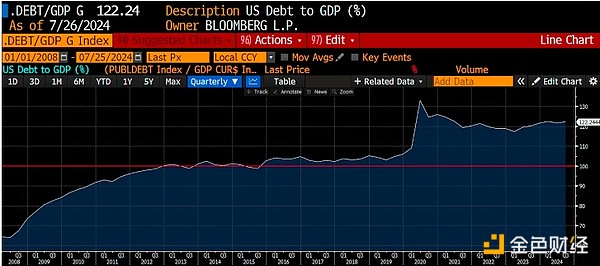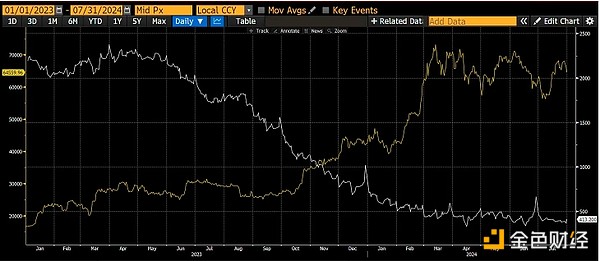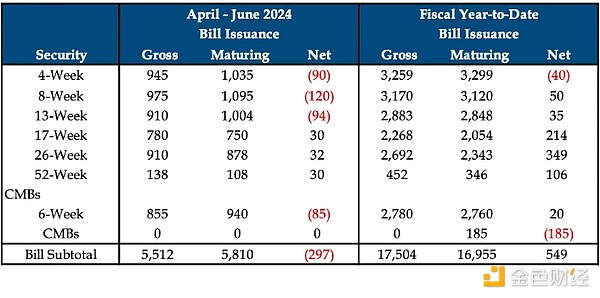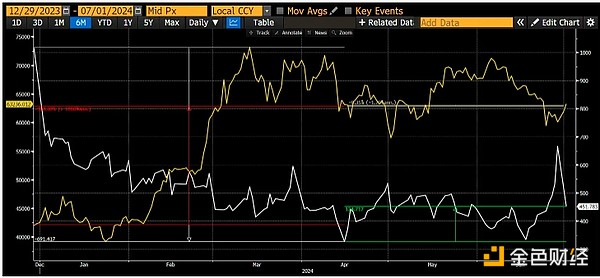Author: Arthur Hayes, Founder of BitMEX; Translated by: Deng Tong, Jinse Finance
There is water everywhere.
All the boards shrunk;
There is water everywhere.
There was not a drop of water to drink.
—Coleridge, The Rime of the Ancient Mariner
I love specialty coffee, but my home brewed coffee was just terrible. I spent a lot of money on coffee beans, but my home brewed coffee always tasted worse than the coffee I had at the cafe. In order to improve my coffee, I started to pay more attention to the details. I realized that one detail I had been neglecting was the quality of the water.
Now I understand how important water is to the quality of the coffee I brew. I was really struck by an article recently published in Standart issue 35.
A similar phenomenon occurred during my time as a barista, when I learned that more than 98% of a cup of coffee and about 90% of espresso is water.
This realization often comes later in people’s coffee journeys, probably because it’s so much easier to spend money on a new machine with the goal of making better coffee. ‘Ah, you have a conical grinder! That’s why your pour-over is cloudy. Switch to a flat grinder!’ But what if that 2% isn’t the problem? What if focusing on the solvent itself could solve our coffee problems?
– Lance Hedrick, On the Chemistry of Water
My next step is to digest the author's advice and order a home distiller. I know of a local coffee shop that sells mineral concentrates that can be added to your water that will create the perfect base to bring out the intended flavors of their roast. By this winter, my morning cup of tea will be delicious... I hope.
Good quality water is essential for brewing great coffee. Turning to investments, water or liquidity is important for accumulating Sats. This is a recurring theme in my articles. But we often forget its importance and focus on the little things we think will affect our ability to make money.
If you can recognize how, where, why and when fiat liquidity is generated, it is hard to lose money investing. Unless you are Su Zhu or Kyle Davis. If financial assets are denominated in USD, rather than UST, then it makes sense that the amount of global currency and USD debt is the most critical variable.
We should not be looking at the Federal Reserve (Fed), but at the U.S. Treasury. That is how we determine the specific increase and decrease of fiat liquidity under the peace of the United States.
We need to recall the concept of “fiscal dominance” to understand why US Treasury Secretary Janet Yellen views Fed Chairman Jay Powell as her beta cuck towel bitch boy. In periods of fiscal dominance, the need to finance the country overrides any central bank concerns about inflation. This means that bank credit, and thus nominal GDP growth, must be maintained at high levels, even if it leads to inflation that is persistently above target.
Time and compounding determine when power shifts from the central bank to the Treasury. When debt exceeds 100% of GDP, debt will mathematically grow much faster than the economy. After this event horizon, the institution that controls the supply of debt is crowned emperor. This is because the Treasury decides when, how much, and for what terms debt is issued. Moreover, since the government is now addicted to debt-driven growth for survival, it will eventually instruct the central bank to use the printing press to cash the Treasury's checks. Central bank independence be damned!

The outbreak of COVID and the U.S. government’s response of locking people in their homes and paying them into obedience with stimulus checks caused the debt-to-GDP ratio to rise dramatically to over 100%. It was only a matter of time before Yellen made the transition from grandma to bad girl.
There is an easy way that bad girl Yellen can create more credit and stimulate asset markets before the US falls into outright hyperinflation. There are two sanitized pools of money on the Fed’s balance sheet that, if released into the wild, would generate bank credit growth and boost asset prices. The first pool is the reverse repurchase program (RRP). I have discussed this pool in detail, where money market funds (MMFs) park their cash at the Fed overnight and earn interest. The second pool is bank reserves, and the Fed plans to pay interest on this pool in a similar manner.
While the money is on the Fed’s balance sheet, it cannot be rehypothecated into financial markets to generate broad money or credit growth. By bribing banks and money market funds with interest on reserves and RRPs respectively, the Fed’s quantitative easing (QE) program has created financial asset price inflation rather than a surge in bank credit. If QE had not been done in this way, bank credit would have flowed into the real economy, increasing output and goods/services inflation. Given the amount of debt currently under the U.S., strong nominal GDP growth coupled with goods/services/wage inflation is exactly what the government needs to increase taxes and deleverage. So Bad Gurl Yellen took steps to correct this mistake.
Bad Gurl Yellen doesn’t care about inflation. Her goal is to create nominal economic growth so that tax revenues increase and the U.S. debt-to-GDP ratio decreases. Given that no political party or its supporters are committed to cutting spending, deficits will persist for the foreseeable future. Moreover, because the federal deficit is so large, a record high in peacetime, she must use every tool at her disposal to finance the government. Specifically, that means taking as much money as possible off the Fed’s balance sheet and pumping it into the real economy.
Yellen needs to give banks and money market funds something they want. They want a yielding cash-like instrument with no credit, minimal interest rate risk to replace the yielding cash they hold at the Fed. Treasury bills (T-bills) with maturities less than one year and yields slightly more than the Interest on Reserve Balances (IORB) and/or RRP are the perfect substitute. T-bills are an asset that can be exploited in the wild and will generate credit and asset price growth.
Can Yellen afford to issue $3.6 trillion worth of Treasury securities? 1 Definitely. The federal government runs a $2 trillion deficit each year, which must be financed through debt securities issued by the Treasury Department.
Yet Yellen or whoever replaces her in January 2025 does not have to issue Treasury bills to fund the government. She can sell longer-term Treasury bills, which are less liquid and carry more interest rate risk. These securities are not cash equivalents. Moreover, because of the shape of the yield curve, longer-term debt securities yield less than Treasury bills. The profit motive of banks and money market funds prevents them from converting the money they hold at the Fed into anything other than Treasury bills.
Why should we, as crypto traders, care about the flow of money between the Fed’s balance sheet and the broader financial system? Enjoy this beautiful chart.

As RRP (white) has fallen from its highs, Bitcoin (gold) has risen from its lows. As you can see, this is a very tight relationship. As money leaves the Fed’s balance sheet, it increases liquidity, which causes finite financial assets like Bitcoin to soar.
Why does this happen? Let's ask the Treasury Borrowing Advisory Committee (TBAC). In its latest report, TBAC clearly shows the relationship between the increase in Treasury bill issuance and the amount of money market funds hold in RRP.
Large ON RRP balances may indicate unmet demand for Treasuries. During 2023-24, ON RRPs dry up as money funds shift almost one-to-one to Treasuries. This rotation facilitates seamless absorption of record Treasury issuance.
– Slide 17, TBAC July 31, 2024
Money market funds will move cash into Treasuries as long as the yield on Treasuries is slightly higher than the RRP -- currently, the yield on 1-month Treasuries is about 0.05% higher than the funds in the RRP.
The next question is whether bad girl Yellen can coax the remaining $300-400 billion in RRP into Treasuries. If you doubt bad girl Yellen, you will be sanctioned! Ask those poor souls from the "junk countries" what happens when you can't get dollars to buy necessities like food, energy and medicine.
In its recent Q3 2024 Quarterly Refinancing Announcement (QRA), the Treasury said it would issue $271 billion in Treasury bills between now and the end of the year. That’s good, but there’s still money left in the RRP. Can she do more?
Let me quickly talk about the Treasury Repo Program. Through this program, the Treasury repurchases illiquid non-Treasury debt securities. The Treasury can fund the purchases by drawing on its general account (TGA) or issuing Treasury bills. If the Treasury increases the supply of Treasury bills and decreases the supply of other types of debt, it will have a net increase in liquidity. Funds will leave the RRP, which is good for dollar liquidity, and as the supply of other types of Treasury securities decreases, these holders will move up the risk curve to replace these financial assets.
The latest repurchase program will purchase up to $30 billion worth of non-marketable securities between now and November 2024. This is equivalent to issuing an additional $30 billion in Treasury bills, raising RRP outflows to $301 billion.
That’s a solid injection of liquidity. But how bad is bad girl Yellen? How badly does she want minority U.S. presidential candidate Momalla Harris to win? I say “minority” because Harris changes her phenotypic affiliation depending on the demographic she’s targeting. That’s a very unique ability she possesses. I’m rooting for her!
The Treasury could inject a massive liquidity injection by reducing the TGA from about $750 billion to zero. They can do this because the debt ceiling goes into effect on January 1, 2025, and by law the Treasury can reduce TGA spending to avoid or prevent a shutdown.
Bad girl Yellen will pump in at least $301 billion and up to $1.05 trillion between now and the end of the year. Wow! That will create a glorious bull market for all risk assets including cryptocurrencies before the election. If Harris still can’t beat the orange man, then I think she needs to become a white male. I believe she has that superpower.
More potential liquidity waiting to be released
Injecting $2.5 trillion into financial markets by draining RRPs over the past 18 months is pretty impressive. But there is a lot more potential liquidity waiting to be unleashed. Can Yellen’s successor (starting in 2025) create a situation where money is pulled out of bank reserves held at the Fed and injected into the broader economy?
In a fiscally dominant era, anything is possible. But how?
For-profit banks will swap one yielding cash-like instrument for another as long as regulators treat capital adequacy the same and the latter offers a higher yield. Currently, Treasury bills offer a lower yield than the reserve balances held by the Fed, so banks will not bid for Treasury bills.
But starting next year, when the RRP approaches zero and the Treasury continues to dump large quantities of T-bills into the market, what will happen? Ample supply and the inability of money market funds to buy T-bills with the money they have deposited at the RRP mean that prices must fall and yields rise. As long as the yield on T-bills rises to a few basis points above the rate paid on excess reserves, banks will use their reserves to buy large quantities of T-bills.
Yellen's successor - I bet it's Jamie Dimon - will not be able to resist the ability to stimulate the market for the political benefit of the ruling party and continue to flood the market with Treasury bills. Another $3.3 trillion in bank reserve liquidity is waiting to be injected into financial markets. Chant with me: Bills, Baby, Bills!
I believe TBAC is quietly hinting at this possibility. Here is another excerpt from the same previous report, with my comments in [bold]:
Looking ahead, a number of factors may warrant further examination when considering future Treasury issuance:
[TBAC wants the Treasury to think about the future and how large Treasury issuance should be. Throughout the speech, they advocated that Treasury issuance should hover around 20% of total net debt issuance. I believe they tried to explain what would cause this ratio to increase and why banks would buy these Treasury bills.]
– The evolution and ongoing assessment of the banking regulatory landscape (covering liquidity and capital reforms, among others) and the impact on banks and dealers’ ability to meaningfully participate in the primary Treasury market to intermediate and warehouse (anticipated) future U.S. Treasury maturities and supply
[Banks don’t want to hold more longer-dated notes or bonds because they would attract tighter collateral requirements from regulators. They quietly say, we won’t buy any more longer-dated debt because it hurts their profitability and is too risky. If the primary dealers go on strike, the Treasury is screwed because who else has the balance sheet to absorb the big debt auctions.]
– Evolution of market structure and its impact on Treasury market resilience initiatives, including:
> The SEC’s central clearing rule, which requires a significant increase in margin requirements posted to regulated clearing houses
[If the Treasury market moves on exchanges, dealers will need to post billions of dollars worth of additional collateral. They cannot afford to do so, and the result will be a drop in participation.]
> The predictability of future (expected) U.S. Treasury auction sizes and cash management and benchmark Treasury issuance
[If deficits continue to remain this large, the amount of debt issued is likely to increase substantially. Therefore, the role of Treasury bills as a "shock absorber" will only become more important. This means that more Treasury bills will need to be issued.]
> Future money fund reform and potential incremental structural demand for treasury bills
[If money market funds return to the market after the RRP is fully exhausted, Treasury issuance will exceed 20%.]
– Slide 26, TBAC July 31, 2024
The banks have effectively gone on strike buying longer term Treasuries. Yellen and Powell nearly caused the banking industry to collapse by stuffing the banks with Treasuries and then jacking up rates between 2022 and 2023… RIP Silvergate, Silicon Valley Bank, and Signature Bank. The remaining banks are not going to mess around anymore and wonder what will happen if they buy high priced Treasuries in bulk again.
Case in point: U.S. commercial banks have bought only 15% of non-Treasury U.S. Treasury securities since October 2023.2 This doesn’t bode well for Yellen, because she needs the banks to step up as the Fed and foreigners exit the scene. I think as long as banks buy Treasuries, they will be happy to perform their duties, because Treasuries have a similar risk profile to bank reserves, but with a higher yield.
Yellen is in the spotlight again
The fall in USDJPY from 160 to 142 has sent shockwaves through global financial markets. Many were hit last week and told to sell what they can. A moment ago it was a textbook correlation. USDJPY will hit 100 but the next wave of shocks will be driven by capital repatriation from Japanese companies’ overseas assets, not just hedge fund puppets unwinding yen carry trades. 3 They will sell US Treasuries and US stocks (mostly big tech stocks like NVIDIA, Microsoft, Google, etc.).
Global markets went ballistic when the BoJ tried to raise rates. They capitulated and announced that a rate hike was out of the question. The worst-case scenario from a fiat liquidity perspective is a sideways yen with no net new positions funded with cheap yen. With the threat of the yen carry trade unwinding having passed, bad girl Yellen’s market manipulation is once again in the spotlight.
No liquidity = bankruptcy
Without water, you die. Without liquidity, you go bankrupt.
Why have crypto risk markets been moving sideways to down since April this year? Most tax revenues occur in April, which requires the Treasury to borrow less. We can observe this in the amount of Treasury bills issued from April to June.

Liquidity is removed from the system due to the net reduction in outstanding Treasury bills. Even if the government as a whole borrows more, the net reduction in cash-like instruments provided by the Treasury removes liquidity from the market. As a result, cash remains trapped on the Fed's balance sheet RRP, unable to generate financial asset price growth.
This chart of Bitcoin (gold) vs. RRP (white) clearly shows that from January to April, when Treasuries were net issuing, RRP fell and Bitcoin rose. From April to July, when Treasuries were net withdrawn from the market, RRP rose and Bitcoin moved sideways, with a few sharp declines in between. I stopped on July 1 because I wanted to show the interaction before USDJPY rose from 162 to 142, which led to a broad sell-off in risk assets.

So, based on what Yellen said, we know that net issuance of U.S. Treasury bills will be $301 billion between now and the end of the year. If this relationship holds true, Bitcoin will quickly reverse the sell-off caused by the appreciation of the yen. The next stop for Bitcoin is $100,000.
When will the Altcoin season come?
Altcoin are higher beta cryptocurrencies to Bitcoin. But during this cycle, Bitcoin and now Ethereum have seen structural buying in the form of net inflows into U.S.-listed exchange-traded funds (ETFs). Although Bitcoin and Ethereum have pulled back since April, they have escaped the carnage experienced by the Altcoin market . Altcoin will only return after Bitcoin and Ethereum break through $70,000 and $4,000, respectively. Solana will also climb above $250, but the wealth effect of the Solana surge on the entire crypto market will be far less powerful than that of Bitcoin and Ethereum, given the relative market cap. A year-end rally in Bitcoin and Ethereum inspired by USD liquidity will lay a solid foundation for the return of the sexy Altcoin party.
Trading suggestions for the future market
With Treasury issuance and repo programs running in the background, liquidity conditions will improve. If Harris wavers and needs more firepower with the stock market, Yellen will cut the TGA. Regardless, I expect cryptocurrencies to exit their sideways to downside trajectory starting in September. Therefore, I will use the late northern hemisphere summer weakness to add to crypto exposure.
The US election will be held in early November. Yellen will be at peak manipulation in October. There is no better time this year to get liquidity than now. Therefore, I will take advantage of the situation and sell. Instead of liquidating my entire crypto portfolio, I will take profits on my more speculative momentum trades and park the funds in staked Ethena USD (sUSDe). The crypto market is rising, increasing the odds of Trump winning. Trump's odds peaked after the assassination attempt and Slow Joe's poor debate performance. Kamala Harris is a first-rate political figurehead, but she is not an octogenarian vegetable. That's all she needs to beat Trump. The election is a coin toss, and I would rather watch the chaos from the sidelines and return to the market after the US debt ceiling is raised. I expect this to happen sometime in January or February.
Once the US debt ceiling farce is over, liquidity will pour out from the Treasury and the Fed to get the market back on track. Then, the bull run will truly begin. $1 million Bitcoin remains my base case.
PS: China will finally unleash its long-awaited bazooka fiscal stimulus once bad girl Yellen and towel boy Powell team up. The 2025 US-China crypto bull run will be brilliant.
Yachtzee!
Notes
1. This is the total amount of bank reserves held by the Federal Reserve and the RRP.
2. According to the H.8 Fed report, from the week ending September 27, 2023 to July 17, 2024, commercial banks purchased $187.1 billion worth of U.S. Treasuries. I assume that during the same period, money market funds purchased 100% of all Treasuries issued. During the same period, the Treasury issued $1,778 billion worth of debt securities other than Treasuries. Banks accounted for 15% of that.
3. Japanese companies include Japanese insurance companies, pension funds, businesses, households and Japanese banks.








